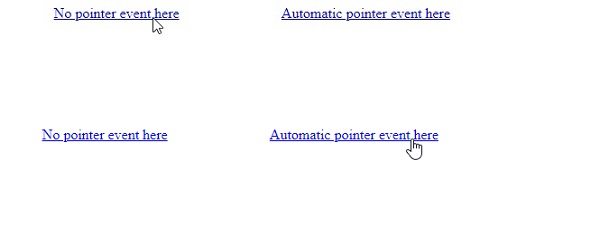
 Data Structure
Data Structure Networking
Networking RDBMS
RDBMS Operating System
Operating System Java
Java MS Excel
MS Excel iOS
iOS HTML
HTML CSS
CSS Android
Android Python
Python C Programming
C Programming C++
C++ C#
C# MongoDB
MongoDB MySQL
MySQL Javascript
Javascript PHP
PHP
- Selected Reading
- UPSC IAS Exams Notes
- Developer's Best Practices
- Questions and Answers
- Effective Resume Writing
- HR Interview Questions
- Computer Glossary
- Who is Who
Controlling Whether Mouse & Touch Allowed with CSS pointer-events Property
Using the CSS pointer-events property we can control whether a mouse and touch are allowed on an element.
The syntax of CSS pointer-events property is as follows −
pointer-events: auto|none;
Above,
auto is default. Element reacts to pointer events, whereas
none: Element does not react to pointer events
Example
The following examples illustrate CSS pointer-events property.
<!DOCTYPE html>
<html>
<head>
<style>
a {
margin: 10vh;
pointer-events: none;
}
a:last-of-type {
pointer-events: auto;
}
</style>
</head>
<body>
<a href=#>No pointer event here</a>
<a href=#>Automatic pointer event here</a>
</body>
</html>
Output
This will produce the following result −

Example
<!DOCTYPE html>
<html>
<head>
<style>
select {
margin: 10vh;
pointer-events: none;
background-color: mistyrose;
}
</style>
</head>
<body>
<select>
<option>No event here </option>
<option>a</option>
<option>b</option>
<option>c</option>
</select>
</body>
</html>
Output
This will produce the following result −


Advertisements
